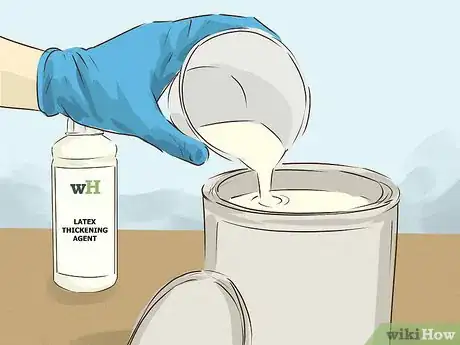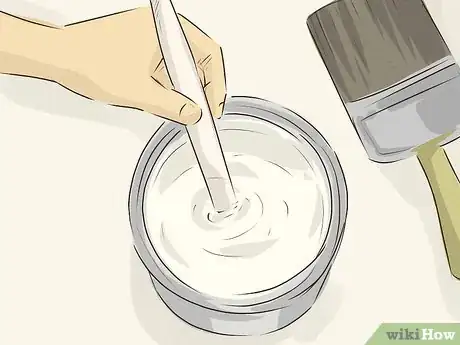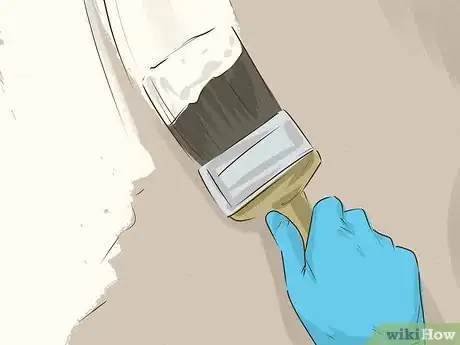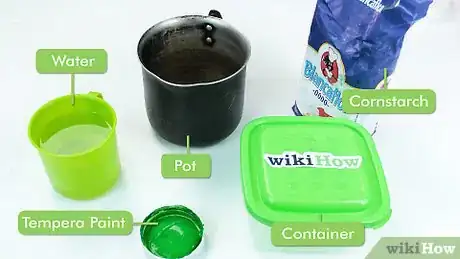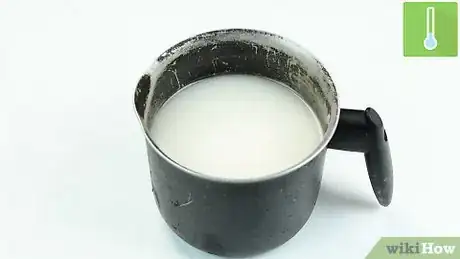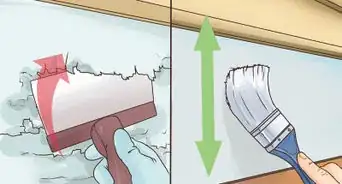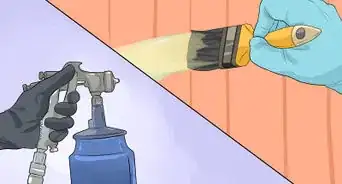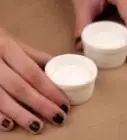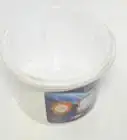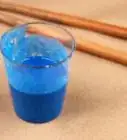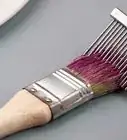This article was co-authored by Kelly Medford. Kelly Medford is an American painter based in Rome, Italy. She studied classical painting, drawing and printmaking both in the U.S. and in Italy. She works primarily en plein air on the streets of Rome, and also travels for private international collectors on commission. She founded Sketching Rome Tours in 2012 where she teaches sketchbook journaling to visitors of Rome. Kelly is a graduate of the Florence Academy of Art.
There are 9 references cited in this article, which can be found at the bottom of the page.
This article has been viewed 259,886 times.
Paint comes in different viscosities depending on the type of paint or mixing technique used. Sometimes you need the paint to be thicker than it is when you open it. You may need thicker paint to cover a darker color on a wall or to turn school paint into finger paint. Thickening agents can help get the paint to the desired thickness and add texture to your artwork.[1]
Steps
Thickening Latex Wall Paint
-
1Buy a thickening agent. You can buy a thickening agent for your paint from a local home improvement store. Most thickening agents for latex paint are made with water-soluble hydroxyethyl cellulose which works well with the latex.[2]
- Make sure the thickening agent says it works with latex paint.
-
2Add the thickening agent to the paint. Read the directions on the bottle of thickening agent to find out how much to use. Typically you will add it by the tablespoon depending on how much paint you have.[3]
- For the best result, add a smaller amount than called for, and then slowly add more until you get the thickness you need.
- Adding more than the manufacturer’s recommended amount can cause the paint to crack and peel when applied to the wall.
Advertisement -
3Stir the paint. Use a paint stick to slowly stir the thickening agent into the paint. The paint will thicken as you stir. If the paint still isn’t thick enough, add more thickening agent in small amounts as you stir.
-
4Test the paint. Paint a small part of the wall to test the thickness of the paint. Let this paint dry completely before checking the results. The paint should not have cracks or be peeling in any way. If the paint looks great and has an even color, you can finish painting the rest of the wall.
Making School Tempera Paint Thicker
-
1Gather the materials needed. You will need cornstarch, water, a pot, tempera paint, and a sealable container to make your paint thicker. Have these materials ready when you begin this project.[4]
-
2Heat cornstarch and water. Add 4 teaspoons of cornstarch to 3 cups of water in a pot. Mix them together until they’re combined. Heat the mixture on low heat stirring frequently. Stir until the cornstarch has dissolved and the mixture becomes smooth and thick.[5]
-
3Cool the mixture. When the mixture is smooth and thick, remove it from the heat and allow it to cool. Stir the mixture after it has completely cooled.[6]
-
4Add the cornstarch mixture to the paint. Slowly add the cornstarch mixture to the tempera paint stirring occasionally. Use a spoon to add the cornstarch mixture or slowly pour it into the paint. Add the cornstarch mixture until the paint reaches the thickness you desire.[7]
-
5Store the extra cornstarch mixture. Use a sealable container to store any extra cornstarch mixture. You can use the cornstarch thickening agent to make tempera paint thicker in the future.
Thickening Acrylic Paints
-
1Purchase a medium to add to your paints. Many art stores carry house brand paint additives that are designed to be mixed with acrylic paints. Liquitex and Golden are two popular manufactures of painting medium additives. Look for a matte or gel medium that dries clear to maintain the color of your paints.[8]
- Mix a small amount of the medium with your paint.
- Stir the paint and test the thickness on a small sample paper.
- Blow dry the sample and observe the color and thickness of your brush stroke.
- Add more medium if you desire a thicker paint.
-
2Use a texture gel to add body to your paint. Many gel compounds contain additives to mimic sand or stucco. Combine the texture gel with your paint to give the paint a textured feel.[9]
- You can experiment with adding sand or sawdust in small amounts to add additional texture.
-
3Mix modeling paste into the paint. Work a small amount of modeling paste to add thickness to your paints that will show up in your brushstrokes.[10]
- Modeling paste dries white and may alter the colors of your paints.
Adding Thickness to Oil Paints
-
1Combine beeswax and turpentine to create a paste. Mix 1 part beeswax with 3 parts turpentine. Stir the turpentine into the beeswax until an even mixture is formed.[11]
-
2Work the paste into your paint to achieve the desired thickness. Mix the paint and paste directly on your palette.
-
3Use a commercial paint medium. Visit your local art store and browse the selection of oil paint mediums. There are many commercial paint mediums that add texture or thickness to paints. Choose your medium based on the look you desire for your painting; some mediums can change the gloss or color of the paint.
- Combine the medium with the paint according to the package instructions.
- Opt for an alkyd medium to help your paint dry quicker.[12]
- Adjust the amount of medium you add to your paints until you reach the desired consistency.
Expert Q&A
-
QuestionWhat will thicken oil paint?
 Kelly MedfordKelly Medford is an American painter based in Rome, Italy. She studied classical painting, drawing and printmaking both in the U.S. and in Italy. She works primarily en plein air on the streets of Rome, and also travels for private international collectors on commission. She founded Sketching Rome Tours in 2012 where she teaches sketchbook journaling to visitors of Rome. Kelly is a graduate of the Florence Academy of Art.
Kelly MedfordKelly Medford is an American painter based in Rome, Italy. She studied classical painting, drawing and printmaking both in the U.S. and in Italy. She works primarily en plein air on the streets of Rome, and also travels for private international collectors on commission. She founded Sketching Rome Tours in 2012 where she teaches sketchbook journaling to visitors of Rome. Kelly is a graduate of the Florence Academy of Art.
Professional Artist You can always mix beeswax or impasto medium into the paint to help it thicken up.
You can always mix beeswax or impasto medium into the paint to help it thicken up. -
QuestionCan I use hair gel products to thicken acrylic paint?
 Community AnswerNo.
Community AnswerNo. -
QuestionIs there a way to change a semigloss finish to an eggshell finish?
 Community AnswerIf you lightly sand a glossy finish, it will look more matte. It may not be as durable since you are making it more porous as well, but if just the look is what you're going for, this will work.
Community AnswerIf you lightly sand a glossy finish, it will look more matte. It may not be as durable since you are making it more porous as well, but if just the look is what you're going for, this will work.
Warnings
- 1-2 drops of Oil of Wintergreen would prevent mould forming from flour or cornstarch, but it is toxic and has to be handled with Extreme Care. Not for children to use at all. I have successfully used it in boiled paper mash for modelling.⧼thumbs_response⧽
- Do not use cornstarch as a thickening agent for wall paint. This can grow mold in the paint over time.⧼thumbs_response⧽
- Test the paint out on a small part of the wall before painting the entire wall.⧼thumbs_response⧽
- Using the stove to heat the cornstarch and water should be done by a responsible adult.⧼thumbs_response⧽
References
- ↑ http://www.housepaintingguide.org/paint-viscosity-a-look-at-the-basics/
- ↑ https://celluloseether.com/sidleycel-hydroxyethyl-cellulose/
- ↑ https://www.merchantcircle.com/articles/How-to-Thicken-Wall-Paint/1053308
- ↑ https://www.schoolpaints.com/2012/07/how-to-thicken-school-tempera-paint.html
- ↑ http://www.schoolpaints.com/2012/07/how-to-thicken-school-tempera-paint.html
- ↑ https://www.schoolpaints.com/2012/07/how-to-thicken-school-tempera-paint.html
- ↑ https://www.schoolpaints.com/2012/07/how-to-thicken-school-tempera-paint.html
- ↑ https://www.youtube.com/watch?v=h1rfWYKcWC4
- ↑ http://www.art-is-fun.com/acrylic-mediums/
- ↑ https://homesthetics.net/how-to-thicken-acrylic-paint/
- ↑ Kelly Medford. Professional Artist. Expert Interview. 10 March 2021
- ↑ Kelly Medford. Professional Artist. Expert Interview. 10 March 2021
About This Article
To thicken latex wall paint, add a thickening agent, which you can buy at a home improvement store, to the paint according to the instructions provided. Then, stir the agent into the paint with a paint stick. For acrylic paints, try adding a medium like Liquitex or Golden to your paint. You can also try mixing in some modeling paste, but bear in mind that it dries white so it might change the paint's color. Additionally, stir in a little sand or sawdust to give your acrylic paint more texture. To find out how to thicken oil paint or how to give acrylic paint texture, read on!

